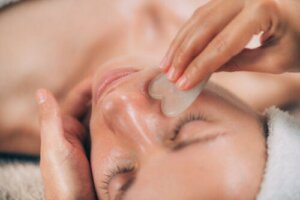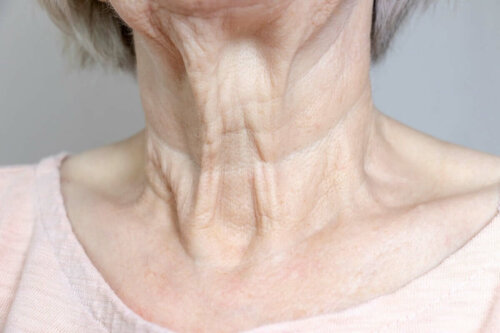Description, Characteristics, and Benefits of Gua Sha

Gua sha is a traditional Chinese medicine technique that’s about 2,000 years old. Gua means “to scrape” and “sha” translates to “sand.” We also know it as “kerokan.”
In effect, in this treatment, a therapist rubs the skin with a flat jade or quartz stone. Nowadays it’s part of the alternative or natural therapies. The objective is to contribute to addressing some health problems. This is because it helps relax muscles, relieve pain, promote tissue drainage and improve circulation.
People have also begun to use it for aesthetic purposes, as part of anti-aging treatments, as it seemingly reduces wrinkles.
Gua sha tools
A jade or quartz stone is the main implement for the gua sha technique and is usually shaped like a heart.
There are different shapes for different parts of the body. For instance, some look like fish, others like a bird’s foot while others are rectangular. In addition to this, there are jade massage rollers and also facial oils, and moisturizing cream.
The benefits of gua sha
These haven’t been fully studied scientifically, although its advocates claim it can successfully treat various conditions. These depend on the type of stone.
For instance, jade has soothing properties and quartz helps reduce inflammation, improve circulation, and stimulate lymphatic drainage.
Migraines, arthritis, neck and back pain
Gua sha is traditionally used to treat the symptoms of various inflammatory ailments as well as chronic pain. Moreover, some claim it helps relieve migraines, as well as the neck and back pain resulting from poor posture.
Massage with the gua sha technique relieves muscle tension. According to research, it was an effective treatment for chronic neck pain compared to other techniques — such as heating pads.
Also, a clinical study stipulated its effectiveness in the treatment of migraine, even in patients who didn’t respond to over-the-counter pain relievers.

Perimenopausal syndrome and swollen breasts
Perimenopause is a set of symptoms that become present as women approach the age of menopause. Among the most common signs are the following:
- Irregular sleep periods
- Absent or excessive menstruation and dysmenorrhea
- Anxiety
- Chronic fatigue syndrome
- Choking sensation or suffocation
However, a study found that gua sha can help reduce the symptoms of perimenopause in some women. Also, they’ve used it to treat breast swelling.
Thus, research indicates that women who receive a gua sha massage after childbirth are less likely to suffer breast engorgement. This greatly improves the breastfeeding process.
Aesthetic purposes
Currently, most of the gua sha attention focuses on applications for aesthetic purposes. People use it as an anti-aging treatment as it supposedly reduces wrinkles and tones down the skin.
For such purposes, people do gua sha on the back, buttocks, arms, and legs of a person. They also do it as facial massage. The goal is to stimulate blood circulation and help absorb the products used.
Learn about The Benefits of Shiatsu Massage for Your Body
Contraindications
Gua sha is a natural, non-invasive treatment and thus, safe. However, rubbing or scraping the skin with the massage stone may lead to bruising that disappears in a few days.
There are some contraindications though:
- It isn’t suitable for people who’ve recently undergone surgery, particularly in the area to massage
- It isn’t suitable for those with coagulation problems or who are undergoing anticoagulant therapy as the application of this technique may break some small blood vessels
- Finally, don’t rub on injuries such as blows, cuts, wounds, edema, or thrombi
How to do gua sha
The gua sha technique must be done by a properly trained person experienced with this technique. The stone must glide upwards and only in one direction when massaging the body. The same applies to the face. Let’s see some examples:
- Neck. They start at the nape of the neck and make upward and inside out movements, using the heart-shaped side and exerting a little more pressure at the base.
- Facial contour. They move from the chin towards the ear, following the contour of the face with the same side of the stone. They exert light pressure at the end of the movement.
- Cheekbones. They make several movements from the nose towards the cheekbones and the cheekbones towards the ears, also exerting a slight pressure at the end of each movement.
- Nasolabial folds. Here they do diagonal movements, from the end of the lip towards the chin and, likewise, towards the edge of the eyebrows.
- Eye contour. To do this, a therapist begins at the eyebrow and sort of does a line towards the temple using the heart-shaped side of the stone and maintaining an upward movement.
- Forehead and between the eyebrows. The therapist exerts a slight pressure on the convex side of the stone from between the eyebrows, moving upwards to the hairline.

Proven effects
Gua sha treatment has no scientific basis, according to its detractors. There’s no doubt that a massage tones muscles and increases vascularization, but say it occurs regardless of what you do it with. That the stone isn’t necessary so the effects aren’t due to it.
However, several studies revealed that gua sha helps reduce the intensity of neck pain in patients after only one week of use. Another study indicates that this technique helps patients regain mobility and flexibility, and reduce their need for pain medication.
Finally, research conducted at Beijing University used gua sha to activate immune responses and reduce inflammation in mice infected with PR8. This technique inhibited inflammatory infiltration. However, it’s a controlled study only conducted on animals.
Gua sha at night and without make-up
The jade or quartz stone adapts to the contours of the skin for stimulation, as long as the therapist does the moves properly.
Other recommendations to keep in mind are that it’s best to do gua sha in a clean, moisturized face, after removing all makeup. Doing it at night before going to bed not only deters aging but also relaxes the muscles.
All cited sources were thoroughly reviewed by our team to ensure their quality, reliability, currency, and validity. The bibliography of this article was considered reliable and of academic or scientific accuracy.
- Chan ST, Yuen JW, Gohel MD, Chung CP, Wong HC, Kwong KK. Guasha-induced hepatoprotection in chronic active hepatitis B: a case study. Clin Chim Acta. 2011;412(17-18):1686-8.
- Lee MH, et al. A single case of Tourette’s syndrome treated with traditional Chinese medicine. Journal of Acupuncture and Meridian Studies. 2017; 10(1): 55-61.
- Nielsen A. Gua sha: A Traditional Technique for Modern Practice. Londres: Elsevier, 2013.
- Nielsen A, Knoblauch NT, Dobos GJ, Michalsen A, Kaptchuk TJ. The effect of Gua Sha treatment on the microcirculation of surface tissue: a pilot study in healthy subjects. Explore. 2007;3(5): 456-66.
- Nielsen A, Kligler B, Koll BS. Addendum: Safety Standards for Gua sha (press-stroking) and Ba guan (cupping). Complement Ther Med. 2014; 22(3): 446-448.
- Tang K. Gua sha: an ancient therapy for contemporary illnesses. New Jersey: World Scientific, 2019.
- Witham C. Gua Sha: Guía de autotratamiento completo. Málaga: Editorial Sirio, 2015.
This text is provided for informational purposes only and does not replace consultation with a professional. If in doubt, consult your specialist.








